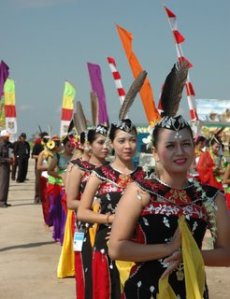Kinship in Dayak society is traced in both lines. Although, in Dayak Iban society, men and women possess equal rights in status and property ownership, political office has strictly been the occupation of the tradition
al Iban Patriarch. Overall Dayak leadership in any given region, is marked by titles, a Penghulu for instance would have invested authority on behalf of a network of Tuai Rumah’s, and so on to a Temenggung or Panglima. It must be noted that individual Dayak groups have their social and hierarchy systems defined internally, and these differ widely from Ibans to Ngajus and Benuaqs to Kayans.
The most salient feature of Dayak social organisation is the pra ctice of Longhouse domicile. This is a structure supported by hardwood posts that can be hundreds of metres long, usually located along a terraced river bank. At one side is a long communal platform, from which the individual households can be reached. The Iban of the Kapuas and Sarawak have organized their Longhouse settlements in response to their migratory patterns. Iban Longhouses vary in size, from those slightly over 100 metres in length to large settlements over 500 metres in length. Longhouses have a door and apartment for every family living in the longhouse. For example, a Longhouse of 200 doors is equivalent to a settlement of 200 families.
ctice of Longhouse domicile. This is a structure supported by hardwood posts that can be hundreds of metres long, usually located along a terraced river bank. At one side is a long communal platform, from which the individual households can be reached. The Iban of the Kapuas and Sarawak have organized their Longhouse settlements in response to their migratory patterns. Iban Longhouses vary in size, from those slightly over 100 metres in length to large settlements over 500 metres in length. Longhouses have a door and apartment for every family living in the longhouse. For example, a Longhouse of 200 doors is equivalent to a settlement of 200 families.
Headhunting was an important part of Dayak culture, in particular to the Iban and Kenyah. There used to be a tradition of retaliation for old headhunts, which kept the practice alive. External interference by the reign of the Brooke Rajahs in Sarawak and the Dutch in Kalimantan Borneo curtailed and limited this tradition. Apart from massed raids, the practice of headhunting was then limited to individual retaliation attacks or the result of chance encounters. Early Brooke Government reports describe Dayak Iban and Kenyah War parties with captured enemy heads. At various times, there have been massive coordinated raids in the interior, and throughout coastal Borneo, directed by the Raj during Brooke’s reign in Sarawak. This may have given rise to the term, Sea Dayak, although, throughout the 19th Century, Sarawak Government raids and independent expeditions appeared to have been carried out as far as Brunei, Mindanao, East coast Malaya, Jawa and Celebes. Tandem diplomatic relations between the Sarawak Government (Brooke Rajah) and Britain (East India Company and the Royal Navy) acted as a pivot and a deterrence to the former’s territorial ambitions, against the Dutch administration in the Kalimantan regions and client Sultanates.
Metal-working is elabo rately developed in making mandaus (machetes – ‘parang’ in Indonesian ). The blade is made of a softer iron, to prevent breakage, with a narrow strip of a harder iron wedged into a slot in the cutting edge for sharpness. In headhunting it was necessary to able to draw the parang quickly. For this purpose, the mandau is fairly short, which also better serves the purpose of trailcutting in dense forest. It is holstered with the cutting edge facing upwards and at that side there is an upward protrusion on the handle, so it can be drawn very quickly with the side of the hand without having to reach over and grasp the handle first. The hand can then grasp the handle while it is being drawn. The combination of these three factors (short, cutting edge up and protrusion) makes for an extremely fast drawing-action. The ceremonial mandaus used for dances are as beautifully adorned with feathers, as are the costumes. There are various terms to describe different types of Dayak blades. The Nyabor is the traditional Iban Scimitar, Parang Ilang is common to Kayan and Kenyah Swordsmiths, and Duku is a multipurpose farm tool and machete of sorts.
rately developed in making mandaus (machetes – ‘parang’ in Indonesian ). The blade is made of a softer iron, to prevent breakage, with a narrow strip of a harder iron wedged into a slot in the cutting edge for sharpness. In headhunting it was necessary to able to draw the parang quickly. For this purpose, the mandau is fairly short, which also better serves the purpose of trailcutting in dense forest. It is holstered with the cutting edge facing upwards and at that side there is an upward protrusion on the handle, so it can be drawn very quickly with the side of the hand without having to reach over and grasp the handle first. The hand can then grasp the handle while it is being drawn. The combination of these three factors (short, cutting edge up and protrusion) makes for an extremely fast drawing-action. The ceremonial mandaus used for dances are as beautifully adorned with feathers, as are the costumes. There are various terms to describe different types of Dayak blades. The Nyabor is the traditional Iban Scimitar, Parang Ilang is common to Kayan and Kenyah Swordsmiths, and Duku is a multipurpose farm tool and machete of sorts.

